Ducati Scrambler Mach 2.0 Review
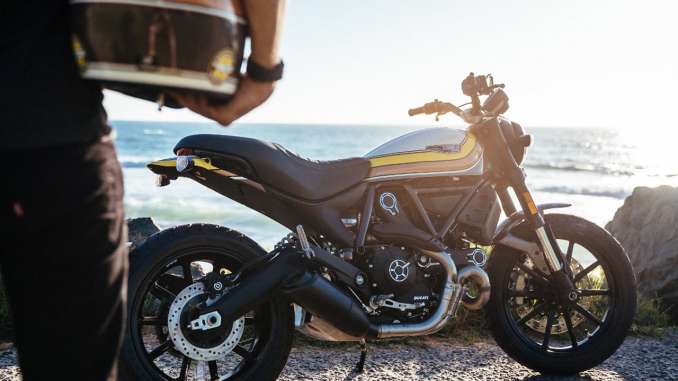
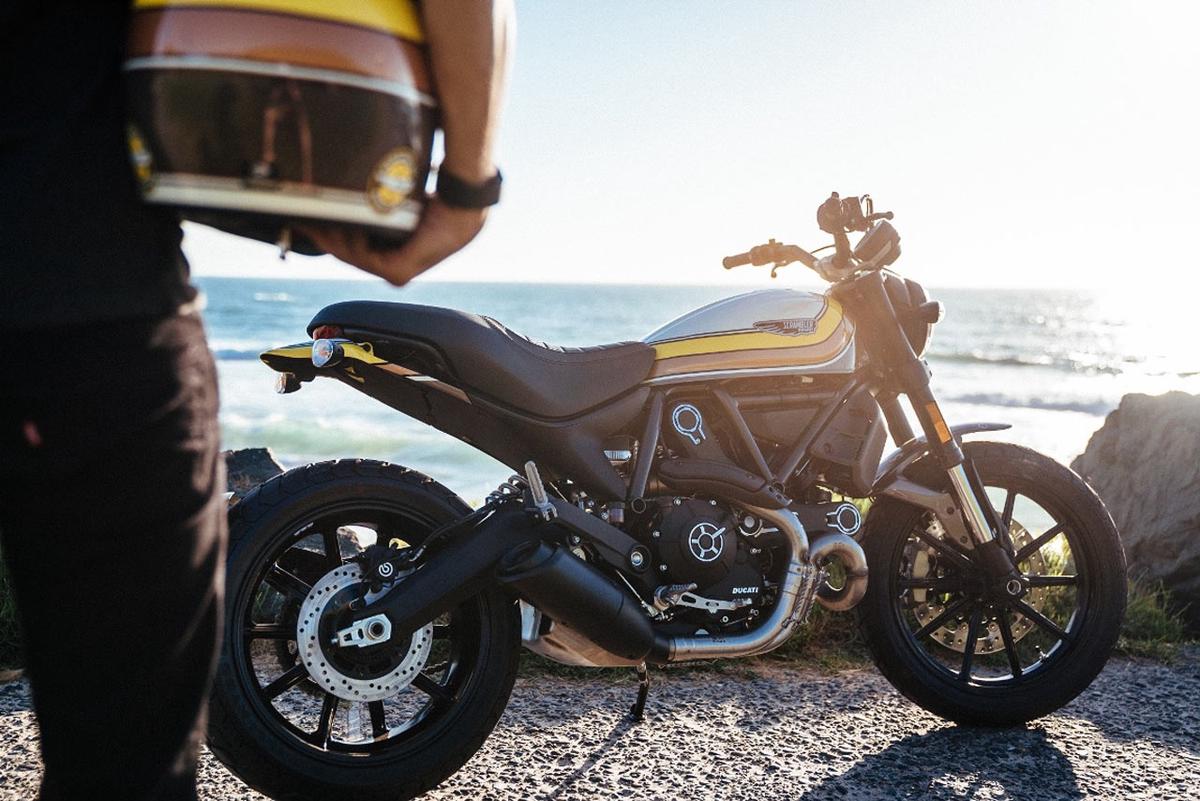
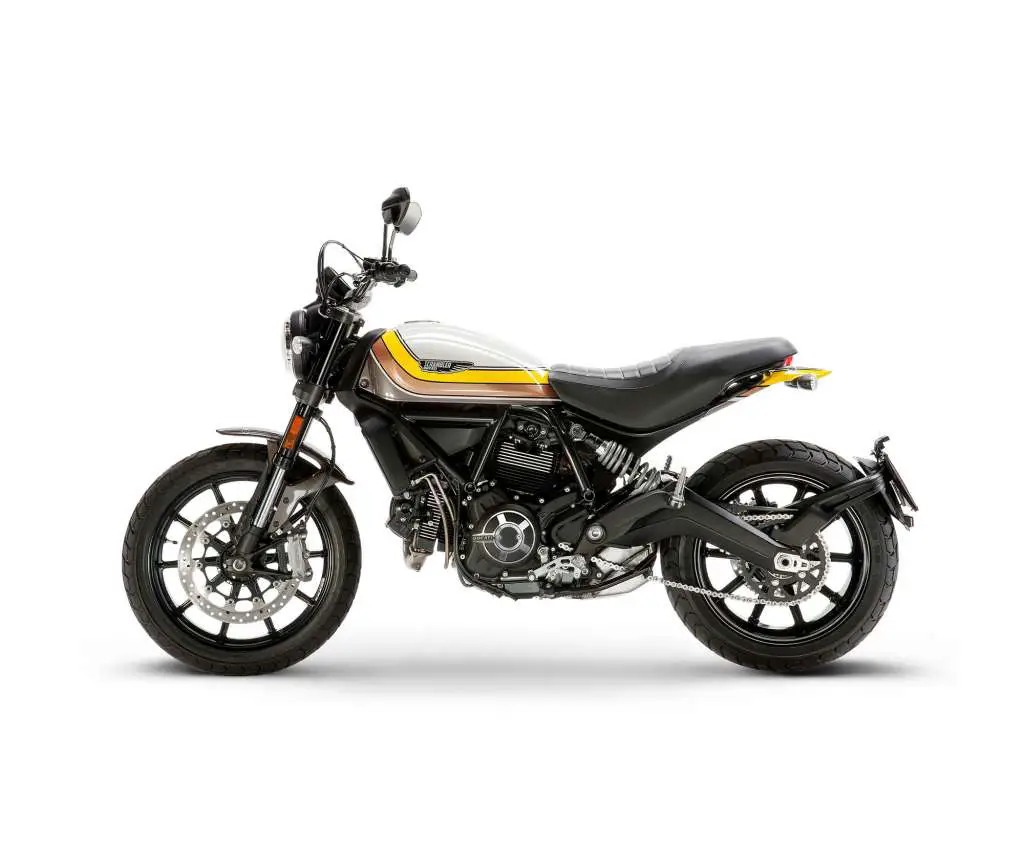
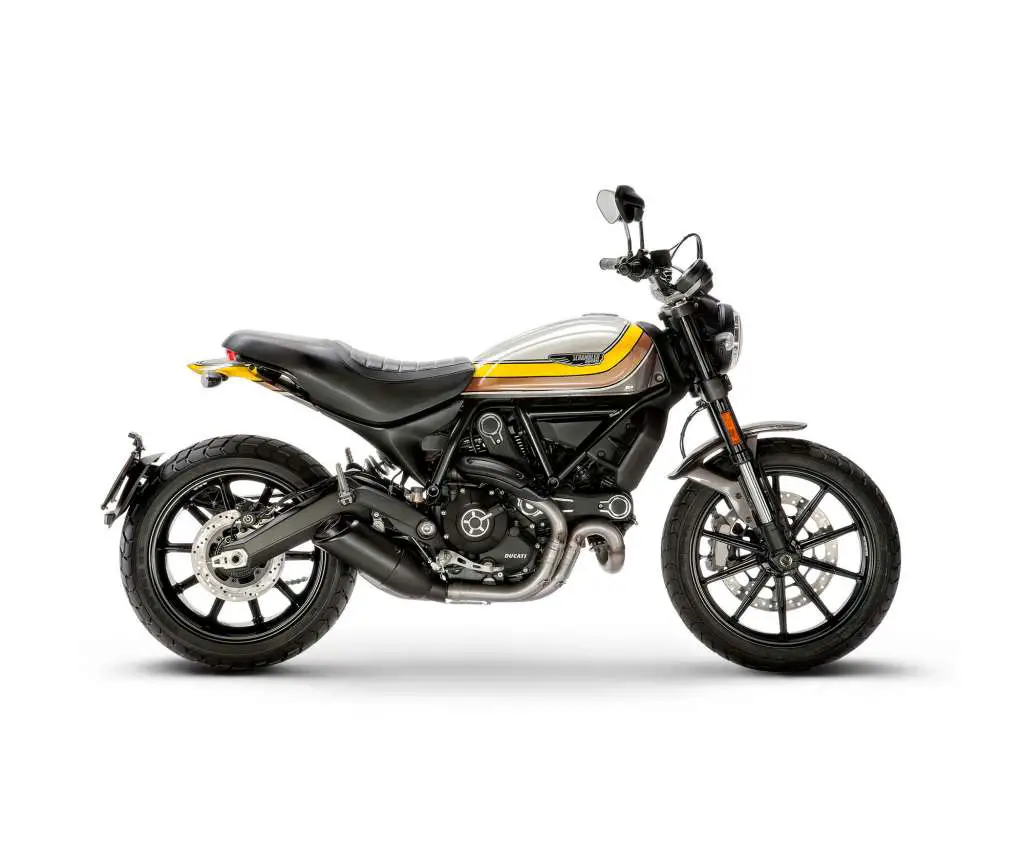
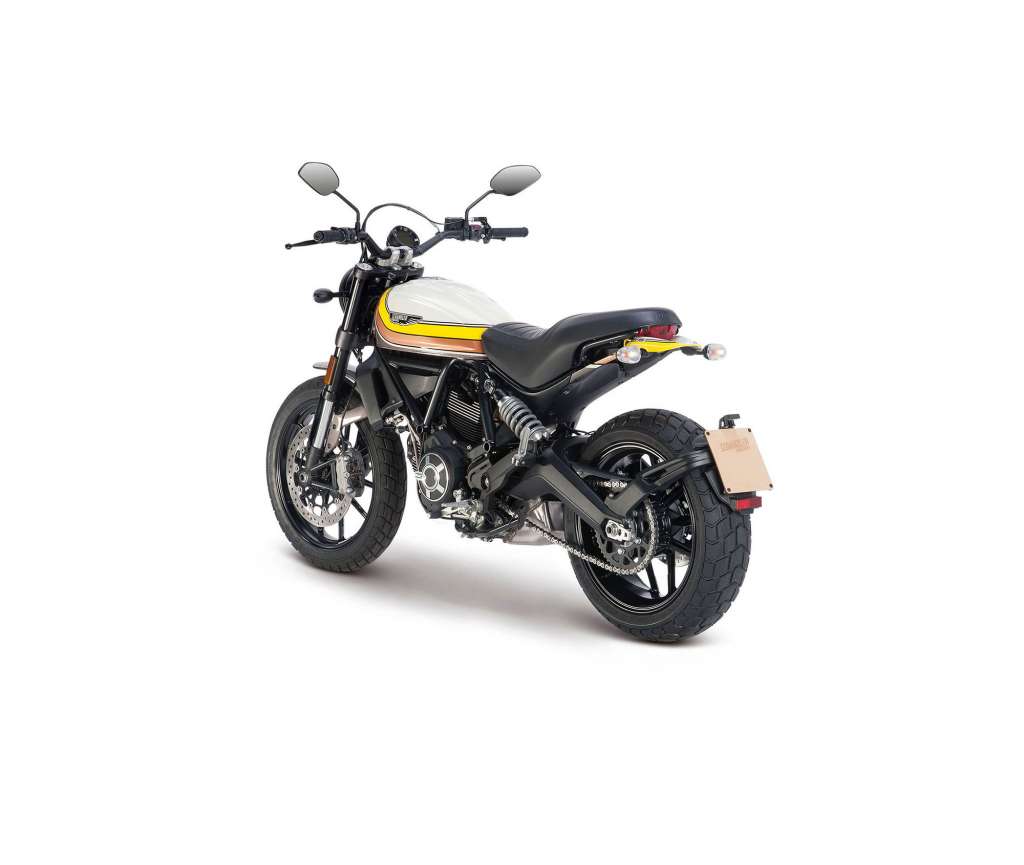
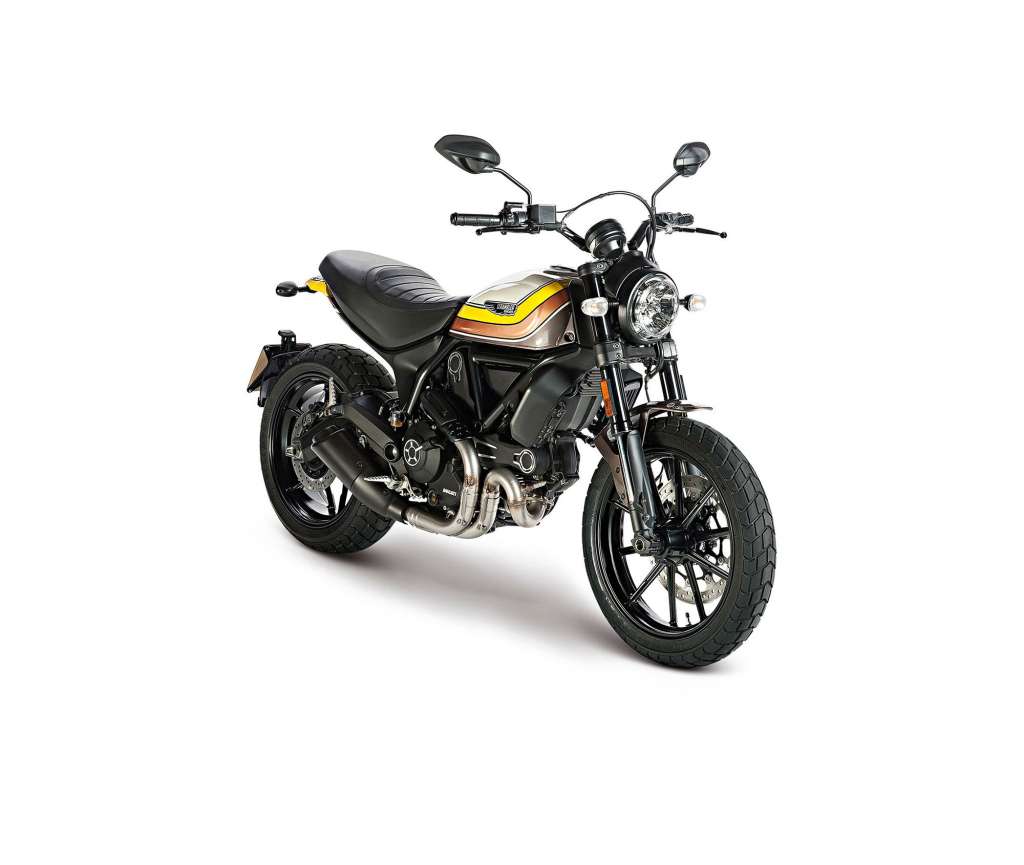
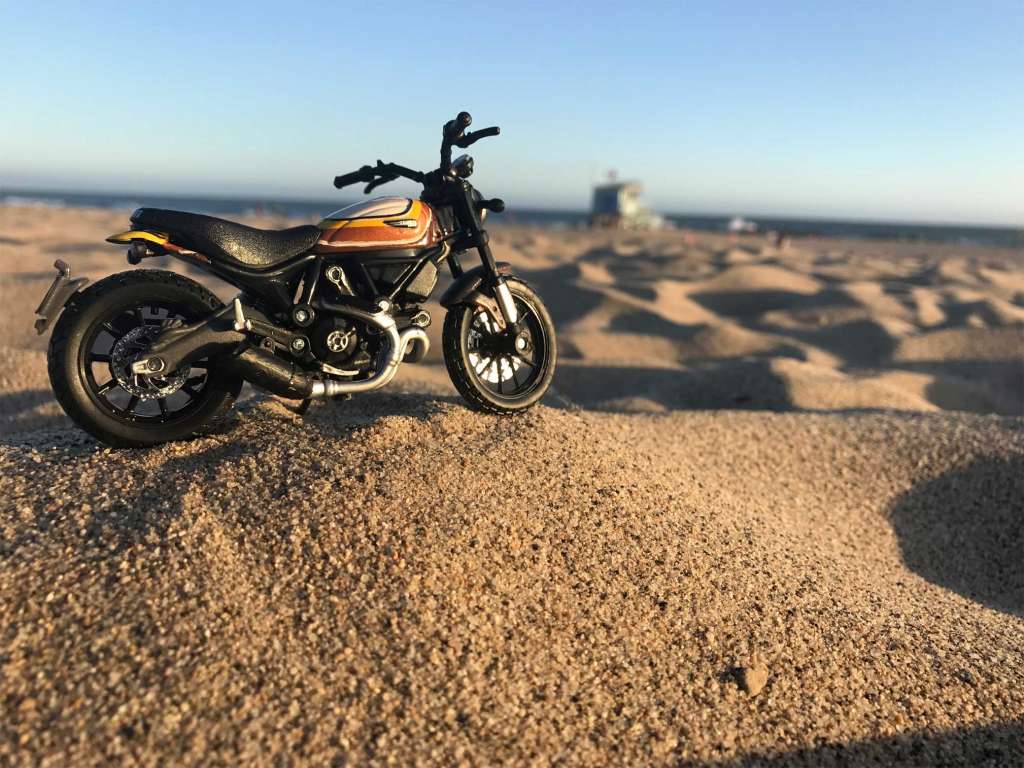
RELIVE THE 70s.
2018 Ducati Scrambler Mach 2.0 REVIEW BY TOTAL MOTORCYCLE
The Scrambler Mach 2.0 was created in collaboration with Roland Sands, renowned Californian designer, inspired by the Bell Cross Idol helmet from the Scrambler® 2017 apparel collection, with its colours evoking the world and ambience typical of the West Coast of the 1970s.
Sleek, with low-slung tapered aluminium handlebars, the Mach 2.0 also features a dedicated Flat Track Pro seat, black exhaust and cylinder head covers, plus Café Racer-style brushed cooling fins. Its graphics are created by renowned Californian designer Roland Sands and feature colours that evoke the typical West Coast style of the '70s. Inspiration for the name of this latest Scrambler version comes from a bike that made Ducati – and motorcycling – history in the '60s. Back in 1965, in fact, the Mach 1 250 was launched: a classic of its day that mounted the same engine as the Scrambler 250 of the time. Needless to say, the choice of name stems from its association with speed and movement: 'Mach', in fact, is the unit of measure for supersonic speeds.
HERITAGE
The name of this original Scrambler® recalls the Mach 1 250, a motorcycle that made the history of Ducati and motorcycling in the 1960s, which was equipped with the same Scrambler 250 engine of the time.
DETAILS
The Scrambler Mach 2.0 features a low variable cross-section aluminium handlebar, Flat Track Pro dedicated seat, black exhaust cover and engine heads and Café Racer brushed fins.
The Land of Joy
The Ducati Scrambler is a contemporary bike that expresses the pure essence of motorcycling. Tried and tested materials such as the aluminium of the rear swingarm and engine covers and the steel of the teardrop tank and frame are combined with new-generation components such as front and rear LED lighting and LCD instruments.
Wide handlebars and a long seat provide a comfortable, relaxed riding position and, together with the low weight, low centre of gravity and slightly knobby tyres, ensure pure riding fun whatever the situation.
The Icon version, in yellow, red and Silver Ice, is joined by two others – Full Throttle, Street Classic and Classic – each offering its own style and performance-related interpretation of the Ducati Scrambler spirit. The Full Throttle is for riders enthralled by the flat-track racing world who have a penchant for pushing things to the limit. The Street Classic and Classic are for devotees to details and a 1970s look who want the uncompromising riding pleasure and comfort of a modern-day bike.
Self expression
Ducati Scrambler is self expression and the Full Throttle, Street Classic and Classic versions offer some great ways of expressing yourself even better. They represent a starting point, providing examples of what the Ducati Scrambler is all about.
2018 Ducati Scrambler Mach 2.0 Totalmotorcycle.com Key Features
Main as-standard features
Ducati Scrambler Mach 2.0
Features
o Spoked aluminium wheels
o Twin-cylinder Desmodue engine Euro 4 type-approved air cooled
o Steel tank with dedicated graphics
o Headlight with glass lens
o Machine-finished aluminium belt covers
2018 Ducati Scrambler Mach 2.0 Totalmotorcycle.com Features and Benefits
Post-heritage design
When the Ducati Design Center started working on the Ducati Scrambler the goal immediately became a very clear one: to revive a legend while, simultaneously, building a truly modern bike. A new bike inspired by the iconic 70s model but with all the technical specifications of a present-day one. That's why, for example, the bike features an upside down stanchion fork, alloy rims, a rear monoshock, and front radial-mount calipers.
Everything on the Ducati Scrambler has been designed to be as "Ducati" as possible while remaining faithful to the style of its inspiring predecessor. Firstly, there's the tank, sculptural and lovingly shaped yet loyal to the original teardrop design of the 70s model, including the 'upward sloping' look. Additional character is provided by the tank side covers: made of brushed aluminium, they're interchangeable to allow plenty of scope for personalisation and feature version-specific logos.
Seat and tank have been formed carefully to give the Ducati Scrambler eye-pleasing proportions. A compact bike, the Ducati Scrambler instils confidence from the moment you set eyes on it. It's been sized to make it accessible to all motorcyclists while its long seat maximises comfort and can accommodate a passenger comfortably, because the Ducati Scrambler is all about sharing too.
A great deal of thought has gone into every detail on the Ducati Scrambler, including the ultra-modern rear swingarm and the exhaust pipe routing, a layout that echoes the look seen on the latest Ducati nakeds. The short silencer and the rear mudguard tip have been designed to make the bike more compact, as have the passenger grab handles, hidden by the openings on the upper part of the seat.
Redesigned for the present day, the round headlamp is a key part of the Ducati Scrambler look. Ultra-modern LED light guide technology (used for the side lights) underlines the outstanding level of technical expertise. The filler cap, which sports the inscription "born free – 1962", reflects the closure system in vogue in the 70s; similarly, the key, once inserted in the switchgear on the headlamp unit, recalls the design of the original light switch. Under-seat moulding provides another 70s design throwback.
Components
Lighting
Together with the fuel tank, the front headlamp is one of the most characteristic features of the Ducati Scrambler. Round, classically designed yet contemporary – that is, post-heritage – it has a glass front with a modern, LED-powered light guide around the rim (this acts as a side light). When on, it recalls the popular 70s stratagem of applying protective adhesive tape to off-road bike headlights. The high-beam function is performed by a single bulb hidden behind a Ducati-logoed screen. Moreover, the contrast between the cold white side light and warm yellow headlamp gives the Ducati Scrambler yet another personality boost.
At the rear, instead, lies a full-LED unit. This gives off a suffused light and features a technology unprecedented on motorcycles; this 'soft' effect is, in fact, achieved by combining an opaque light-diffusing lens with a 12-LED electrical card (18 LEDs when the brake is applied).
The bulb-powered indicators – positioned to the sides of the headlamp and on the rear mudguard – match the Scrambler style to perfection. Ducati Scrambler riders are also provided with a hazard light function, activated simply by holding down the left indicator button for three seconds.
Instrumentation
The Ducati Scrambler instrument panel consists of a single, round unit positioned above and slightly to the right of the headlamp. Fully digital, it has an engine rpm scale resonant of those seen on '70s motorcycle speedometers (i.e. in the lower part of the instrument body). As engine revs increase the digits light up clockwise (right to left). Ducati Scrambler instrumentation also features two trip odometers and one total-mileage odometer, a trip fuel indicator, an air temperature display, maintenance reminders, a clock, and fuel reserve and ABS warning lights. Riders can also count on an engine oil pressure warning light, high beam indicator, neutral indicator, turn signal indicators, immobilizer and over-rev warning light.
Controls
Post-heritage styling is also evident on Ducati Scrambler controls. The wide handlebars house a classic wire-connected twist-grip throttle together with an axial-pump front brake lever with 4 different position settings. Minimalist Ducati Scrambler design continues with the cable-actuating clutch lever. The switchgear is characterised by the now-standard yet exclusive "trigger catch" that slides down to cover the starter button when the kill switch is activated. It's the same one used on all Ducati bikes, its high tech design underscoring the post-heritage style of the Ducati Scrambler.
The black painted die cast aluminium footrest plates support the gear change lever and the off-road type rear brake lever.
Engine
An oil cooled L-twin two-valve Euro 4 803 cc engine powers the Ducati Scrambler. Derived from the Monster 796 engine, it has an 88 mm bore, a 66 mm stroke and has been redesigned to give smooth acceleration throughout the rev range. The Desmodue engine on the Ducati Scrambler has light machine-finished aluminium covers, including those on the clutch and alternator. The two belt covers are also made of aluminium and have, likewise, been machine-finished to enhance aesthetics.
To ensure smooth integration with the compact steel teardrop tank, the Desmodue engine on the Ducati Scrambler features a single 50 mm throttle body with two sub-butterfly injectors: this solution ensures fluid power delivery and accurate control of the fuel being aspirated into the cylinders.
Pistons and crankshaft are the same as those on the Monster 796 and Hypermotard 796 power units, while the camshafts have been designed to ensure linear power delivery thanks to the adoption of an 11° valve overlap angle. The 2-in-1 exhaust with aluminium silencer has been specially designed for the Ducati Scrambler. It features an aluminium heat plate for improved rider protection and is EURO 3 compliant.
The gearbox is a 6-speed unit while the multiplate APTC oil bath clutch with cable actuation, while emphasising the minimalist nature of the Ducati Scrambler, provides a light-touch brake lever with outstanding 'feel', a real plus point when it comes to the continuous stop-and-go of inner city traffic. Moreover, it features a torque-linked anti-hopping system that prevents rear wheel chatter when downshifting.
The twin-cylinder Desmodue engine on the Ducati Scrambler has been designed to favour smooth running and fluid acceleration throughout the rev range, putting out 75 hp (55.2 kW) @ 8,250 rpm and 50.2 lb-ft (6.9 kgm) of torque @ 5,750 rpm. Just like the Ducati Scrambler itself, it is designed to be simple and accessible and also features generous 12,000 kilometres maintenance intervals.
Desmo delight
The Ducati Scrambler is iconic, as is the celebrated Ducati Desmo, the engine valve closure system that has made Ducati famous all over the world. This system opens and closes the intake and exhaust valves positively and precisely, using a system of cams and levers. The term desmodromic stems from the Greek words desmos (link) and dromos (stroke); mechanically speaking, the term refers to mechanisms with a control to operate them in one direction (e.g. opening) and another which acts in the opposite direction (closure or return).
However, the desmodromic concept is not a recent one and has been used in the motorcycle and car industries for some time. It first appeared, in a variety of forms, way back at the start of the twentieth century. In 1956 renowned engineer Fabio Taglioni set Ducati off along the desmodromic path: the first bike to feature the solution was the Grand Prix 125, which had three overhead camshafts, driven by a vertical shaft and a bevel gear.
From that point on desmodromic history became a Ducati exclusive and in 1968 the company started producing this timing system as standard with the Mark 3 Desmo 350. This milestone of a motorcycle essentially had the same timing system as current 2-valve twin cylinder engines like the one on the Ducati Scrambler, clear evidence of the concept's soundness. Used on all Ducati models, the system is also employed on Ducati Corse's Superbikes and Desmosedici MotoGP bikes.
Chassis
Frame
The Ducati Scrambler features a twin upper spar steel Trellis frame. Essential and elegant, the Ducati Scrambler frame embraces the engine and extends beneath the seat, providing the stiffness one expects from a real Ducati. Thanks to a steering head angle of 24° and a 112 mm offset on the fork yokes, manoeuvrability is outstanding both in city traffic and on Alpine hairpins. Thanks to the wide handlebars, weaving your way through the urban obstacle course on a Ducati Scrambler is child's play, while the 1445 mm wheelbase maximises stability at high speeds. The steel fuel tank, with that unmistakeable teardrop contour, has a capacity of 13.5 l (3.6 US gal). With an excellent frame and outstanding chassis geometry, the Ducati Scrambler makes for relaxed riding that is easy yet fun. User-friendly and agile, the Ducati Scrambler is a source of endless satisfaction on both city streets and the open road.
Suspension
The Kayaba suspension system on the Ducati Scrambler makes use of a 41 mm upside down stanchion fork and a monoshock with adjustable spring preload. Both provide 150 mm of wheel travel, ensuring the tyres hug the ground whatever the terrain, from city streets to undemanding off-road routes. It is this mix of comfort and performance that makes the Ducati Scrambler unique, letting riders express themselves to the maximum everywhere and anywhere.
Wheels and tyres
All new aluminium 10-spoke wheels – of evident flat-track origin – come as standard on the Ducati Scrambler. The design is a throwback to the days of thin, criss-crossed spokes inserted in the hub. The 3'' x 18'' front rim and the rear 5.5'' x 17'' one have been designed to be light and mount the new enduro-type Pirelli MT60 RS 110/80 ZR18 tyre at the front and the 180/55 ZR17 at the rear; featuring a chunky tread pattern, these tyres are produced exclusively for the Ducati Scrambler. The result is outstanding performance on surfaces of any kind.
Brembo braking system with 2-channel ABS
The Ducati Scrambler features Brembo braking using the Bosch 9.1 MP AMS system with an internal pressure sensor. To combine maximum stopping performance with minimalist styling the front wheel has a single 330 mm disc, no less than 5 mm thick, with a 4-piston Brembo M 4.32B monobloc radial-mount caliper. This heavy duty single-disc front brake solution was chosen to leave a clear view of the wheel design on the right. At the back, instead, a 245 mm disc is gripped by a caliper with a 32 mm piston.
A bit of history
The Scrambler was designed following a request from the Berliner brothers, the US importers of Ducati bikes in the 1960s. They wanted a bike that would suit the tastes of American bikers. Initial contact was established by Giorgio Monetti – famous for his round-the-world ride together with Leopoldo Tartarini – who was then Sales Manager at Ducati. It was agreed that the bike would have to be extremely practical and the design work was entrusted to Renzo Neri, who, even though he was Technical Department Manager at the time, was known to have a skilled hand: the designs for the tank, seat and mudguards are, in fact, his. The first Scrambler went into production in 1962 and was modified uninterruptedly until 1968, when the real "long engine cover" Scramblers appeared, followed by the 250 and 350 versions and, in 1969, the 450.
The first Scrambler series included some bikes with desmodromic cylinder heads and was the subject of continuous technical adjustments until production was discontinued in 1975. For a variety of reasons, the Scrambler was an enormous success. First of all, it embodied the rebellious, unconventional spirit of the time. It also had an exceptional frame, good enough to even be used on the racetrack. Also, it had a purpose-built engine, and great overall performance with a perfect central riding position made it one of the most enjoyable bikes of the period. Last but not least, it was cool: rounded lines with a hint of both classic and modern blended seamlessly with the bright colouring, which stood out against the black chassis setup and chrome tank.
The first Scrambler model is universally acknowledged as the meeting point between the American and European schools of motorcycling. A bike that defined an era, it became a Ducati milestone in much the same way that the 916 and Monster later would.
2018 Ducati Scrambler Mach 2.0 – Totalmotorcycle.com USA Specifications/Technical Details
US MSRP Price: $ USD
Type L-Twin, Desmodromic distribution, 2 valves per cylinder, air cooled
Displacement 803 cc
Bore x stroke 88 x 66 mm
Compression ratio 11:1
Power * 54 kW (73 hp) @ 8,250 rpm
Torque * 67 Nm (49 lb-ft) @ 5,750 rpm
Fuel injection Electronic fuel injection, 50 mm throttle body
Exhaust Exhaust system with single stainless steel muffler, aluminium silencer cover, catalytic converter and 2 lambda probes
Standard ** Euro 4
Emissions and Consumption CO2 ** 5,0 l/100 km – 117 g/km
Gearbox 6 speed
Ratio 1=32/13 2=30/18 3=28/21 4=26/23 5=22/22 6=24/26
Primary drive Straight cut gears; Ratio 1.85:1
Final drive Chain; Front sprocket 15; Rear sprocket 46
Clutch APTC wet multiplate with mechanical control
Frame Tubular steel Trellis frame
Front suspension Upside down Kayaba 41 mm fork
Front wheel travel 150 mm (5.9 in.)
Front wheel 10-spoke in light alloy, 3.00″ x 18″
Front tyre Pirelli MT 60 RS 110/80 R18
Rear suspension Kayaba rear shock, pre-load and rebound adjustable. Aluminium double-sided swingarm
Rear wheel 10-spoke in light alloy, 5.50″ x 17″
Rear wheel Spoked aluminium wheels, 5,50″ x 17″
Rear tyre Pirelli MT 60 RS 180/55 R17
Front brake 330 mm disc, radial 4-piston calliper with ABS as standard equipment
Rear brake 245 mm disc, 1-piston floating calliper with ABS as standard equipment
Wheelbase 1.445 mm (56.9 in.)
Rake 24°
Trail 112 mm (4.4 in.)
Total steering lock 35°
Fuel tank capacity 14 L – 3.7 gallons (US)
Dry weight 170 kg (375 lb)
Wet weight* 186 kg (410 lb)
Seat height 790 mm (31.1 in.)
Max height 1.150 mm (45.3 in.) / brake reservoir
Max width 845 mm (33.3 in.) / mirrors
Max length 2.100 – 2.165 mm (82.7 – 85.2 in.)
Number of seats Dual seat
Standard Equipment Steel tank, headlight with glass lens, LED light-guide and interchangeable aluminium cover, LED rear light with diffusion-light, LCD instruments with interchangeable aluminium cover, machine-finished aluminium belt covers, under-seat storage compartment with USB socket
Dedicated equipment Low aluminium handlebars, flat-track inspired seat, black silencer cover, black engine with brushed fins, dedicated designed logo
Warranty – Maintenance service intervals – Valve clearance check 24 months unlimited mileage – 12,000 km (7.500 m) / 12 months – 12,000 km (7.500 m)
2018 Ducati Scrambler Mach 2.0 – Totalmotorcycle.com Canadian Specifications/Technical Details
Canada MSRP Price: $ CDN
Type L-Twin, Desmodromic distribution, 2 valves per cylinder, air cooled
Displacement 803 cc
Bore x stroke 88 x 66 mm
Compression ratio 11:1
Power * 54 kW (73 hp) @ 8,250 rpm
Torque * 67 Nm (49 lb-ft) @ 5,750 rpm
Fuel injection Electronic fuel injection, 50 mm throttle body
Exhaust Exhaust system with single stainless steel muffler, aluminium silencer cover, catalytic converter and 2 lambda probes
Standard ** Euro 4
Emissions and Consumption CO2 ** 5,0 l/100 km – 117 g/km
Gearbox 6 speed
Ratio 1=32/13 2=30/18 3=28/21 4=26/23 5=22/22 6=24/26
Primary drive Straight cut gears; Ratio 1.85:1
Final drive Chain; Front sprocket 15; Rear sprocket 46
Clutch APTC wet multiplate with mechanical control
Frame Tubular steel Trellis frame
Front suspension Upside down Kayaba 41 mm fork
Front wheel travel 150 mm (5.9 in.)
Front wheel 10-spoke in light alloy, 3.00″ x 18″
Front tyre Pirelli MT 60 RS 110/80 R18
Rear suspension Kayaba rear shock, pre-load and rebound adjustable. Aluminium double-sided swingarm
Rear wheel 10-spoke in light alloy, 5.50″ x 17″
Rear wheel Spoked aluminium wheels, 5,50″ x 17″
Rear tyre Pirelli MT 60 RS 180/55 R17
Front brake 330 mm disc, radial 4-piston calliper with ABS as standard equipment
Rear brake 245 mm disc, 1-piston floating calliper with ABS as standard equipment
Wheelbase 1.445 mm (56.9 in.)
Rake 24°
Trail 112 mm (4.4 in.)
Total steering lock 35°
Fuel tank capacity 14 L – 3.7 gallons (US)
Dry weight 170 kg (375 lb)
Wet weight* 186 kg (410 lb)
Seat height 790 mm (31.1 in.)
Max height 1.150 mm (45.3 in.) / brake reservoir
Max width 845 mm (33.3 in.) / mirrors
Max length 2.100 – 2.165 mm (82.7 – 85.2 in.)
Number of seats Dual seat
Standard Equipment Steel tank, headlight with glass lens, LED light-guide and interchangeable aluminium cover, LED rear light with diffusion-light, LCD instruments with interchangeable aluminium cover, machine-finished aluminium belt covers, under-seat storage compartment with USB socket
Dedicated equipment Low aluminium handlebars, flat-track inspired seat, black silencer cover, black engine with brushed fins, dedicated designed logo
Warranty – Maintenance service intervals – Valve clearance check 24 months unlimited mileage – 12,000 km (7.500 m) / 12 months – 12,000 km (7.500 m)
2018 Ducati Scrambler Mach 2.0 – Totalmotorcycle.com European Specifications/Technical Details
Europe/UK MSRP Price: £ See Dealer for Pricing in GBP (On The Road inc 20% Vat)
Type L-Twin, Desmodromic distribution, 2 valves per cylinder, air cooled
Displacement 803 cc
Bore x stroke 88 x 66 mm
Compression ratio 11:1
Power * 54 kW (73 hp) @ 8,250 rpm
Torque * 67 Nm (49 lb-ft) @ 5,750 rpm
Fuel injection Electronic fuel injection, 50 mm throttle body
Exhaust Exhaust system with single stainless steel muffler, aluminium silencer cover, catalytic converter and 2 lambda probes
Standard ** Euro 4
Emissions and Consumption CO2 ** 5,0 l/100 km – 117 g/km
Gearbox 6 speed
Ratio 1=32/13 2=30/18 3=28/21 4=26/23 5=22/22 6=24/26
Primary drive Straight cut gears; Ratio 1.85:1
Final drive Chain; Front sprocket 15; Rear sprocket 46
Clutch APTC wet multiplate with mechanical control
Frame Tubular steel Trellis frame
Front suspension Upside down Kayaba 41 mm fork
Front wheel travel 150 mm (5.9 in.)
Front wheel 10-spoke in light alloy, 3.00″ x 18″
Front tyre Pirelli MT 60 RS 110/80 R18
Rear suspension Kayaba rear shock, pre-load and rebound adjustable. Aluminium double-sided swingarm
Rear wheel 10-spoke in light alloy, 5.50″ x 17″
Rear wheel Spoked aluminium wheels, 5,50″ x 17″
Rear tyre Pirelli MT 60 RS 180/55 R17
Front brake 330 mm disc, radial 4-piston calliper with ABS as standard equipment
Rear brake 245 mm disc, 1-piston floating calliper with ABS as standard equipment
Wheelbase 1.445 mm (56.9 in.)
Rake 24°
Trail 112 mm (4.4 in.)
Total steering lock 35°
Fuel tank capacity 14 L – 3.7 gallons (US)
Dry weight 170 kg (375 lb)
Wet weight* 186 kg (410 lb)
Seat height 790 mm (31.1 in.)
Max height 1.150 mm (45.3 in.) / brake reservoir
Max width 845 mm (33.3 in.) / mirrors
Max length 2.100 – 2.165 mm (82.7 – 85.2 in.)
Number of seats Dual seat
Standard Equipment Steel tank, headlight with glass lens, LED light-guide and interchangeable aluminium cover, LED rear light with diffusion-light, LCD instruments with interchangeable aluminium cover, machine-finished aluminium belt covers, under-seat storage compartment with USB socket
Dedicated equipment Low aluminium handlebars, flat-track inspired seat, black silencer cover, black engine with brushed fins, dedicated designed logo
Warranty – Maintenance service intervals – Valve clearance check 24 months unlimited mileage – 12,000 km (7.500 m) / 12 months – 12,000 km (7.500 m)
Manufacturer Specifications and appearance are subject to change without prior notice on Total Motorcycle (TMW).
Ducati Scrambler Mach 2.0 Review
Source: https://www.totalmotorcycle.com/motorcycles/2018/2018-ducati-scrambler-mach2-review/



Tidak ada komentar: